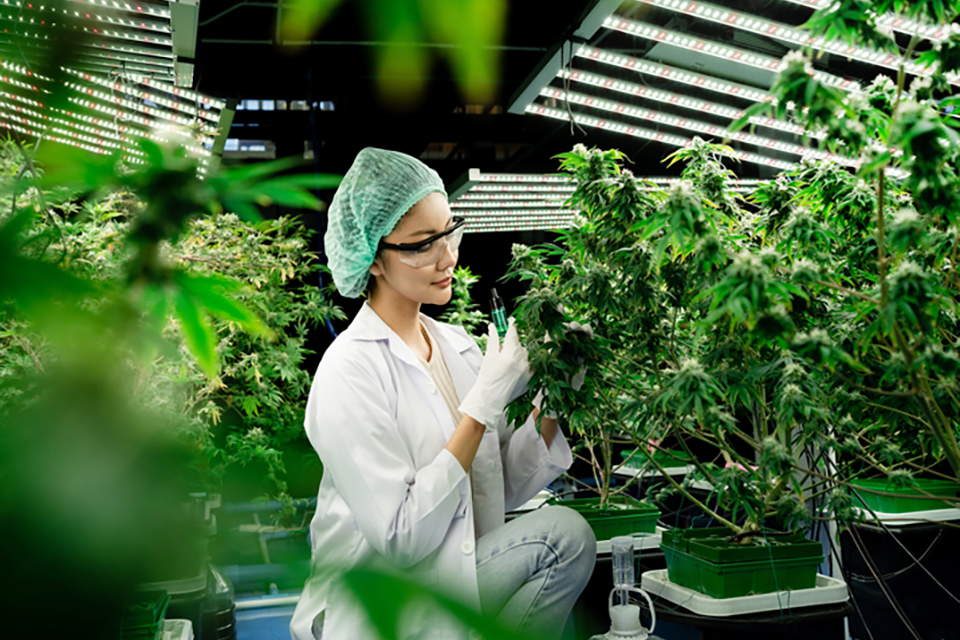
Growing cannabis indoors can be a rewarding experience, but it also comes with its challenges. One of the most frustrating issues for growers is when their cannabis plants refuse to flower. If you find yourself in this situation, don't worry. This guide will walk you through the common reasons why indoor cannabis plants might not flower and provide practical solutions to get your plants back on track.


Understanding the Flowering Process
Before diving into the troubleshooting steps, it's essential to understand the basics of the cannabis flowering process. Cannabis plants go through two primary stages of growth: the vegetative stage and the flowering stage.
Vegetative Stage: During this stage, the plant focuses on growing leaves, stems, and roots. It requires long light periods, typically 18-24 hours of light per day. During this period, the plant builds a strong structure to support future bud production. Healthy root development and robust foliage are key indicators of a successful vegetative phase.
Flowering Stage: This is when the plant starts to produce buds. The light cycle needs to change to 12 hours of light and 12 hours of uninterrupted darkness to trigger flowering. This stage is critical for the development of the cannabinoids and terpenes that give cannabis its effects and flavors. The plant shifts its energy from growing leaves and stems to producing flowers, which will eventually be harvested.
Common Reasons Why Cannabis Plants Won't Flower
Inadequate Light Cycle:
The most common reason indoor cannabis plants fail to flower is due to an incorrect light cycle. Cannabis plants need a strict 12/12 light cycle (12 hours of light and 12 hours of complete darkness) to initiate flowering. Even a small amount of light during the dark period can prevent flowering. Light consistency is key to mimicking the natural conditions that signal the plant to flower. Automating your light schedule with timers can help maintain this consistency.
Light Leaks:
Light leaks during the dark period can confuse the plants and prevent them from entering the flowering stage. Check your grow space for any light leaks and ensure it is completely dark during the 12-hour night cycle. Use blackout materials or double-check seals around doors and windows to prevent any light from entering. It's also helpful to inspect your grow area during the dark cycle to identify and fix any light leaks.
Nutrient Imbalances:
Nutrient deficiencies or imbalances can affect the plant's ability to flower. During the flowering stage, cannabis plants require different nutrients compared to the vegetative stage. A lack of phosphorus, in particular, can hinder the flowering process. Detailed information about nutrient requirements and signs of deficiencies can be beneficial here. For example, phosphorus deficiency often shows as darkening and reddening of the leaves and stems.
Temperature and Humidity:
Extreme temperatures and humidity levels can stress the plants and prevent flowering. Cannabis plants thrive in temperatures between 65-80°F (18-26°C) and humidity levels of 40-50% during the flowering stage. Maintaining these conditions helps ensure the plant's energy is directed towards bud production rather than survival. Using thermometers and hygrometers to monitor and control the environment can prevent stress.
Plant Genetics:
Some cannabis strains have longer vegetative periods and may take more time to start flowering. It's essential to know the characteristics of the strain you're growing. Researching your strain beforehand can help set realistic expectations for the flowering time. Some strains, especially sativa-dominant ones, naturally have longer flowering times and may require more patience.
Stress Factors:
Various stress factors, such as pest infestations, disease, or physical damage, can prevent plants from flowering. Ensuring your plants are healthy and stress-free is crucial for successful flowering. Regular inspections and preventive measures can help keep your plants in optimal health. Stress can also come from transplanting, pruning, or training techniques if not done carefully.
Troubleshooting and Solutions
Adjust the Light Cycle:
Ensure your plants are getting a strict 12/12 light cycle. Use timers to automate the light schedule and prevent any disruptions. If you're using a grow tent, make sure it's lightproof to avoid any light leaks. Consistency is crucial for signaling the plant to transition to the flowering stage. Gradually reducing the light period from 18/6 to 12/12 over a week can also help ease the transition.
Check for Light Leaks:
Inspect your grow space for any sources of light during the dark period. Even small light leaks from digital timers, power strips, or windows can prevent flowering. Use blackout materials to cover any potential sources of light. Create a checklist to systematically check all potential light leak sources. Tape over LED indicators on electronic devices and use heavy-duty curtains or lightproof tape to seal any gaps.
Nutrient Management:
Transition to a nutrient mix designed for the flowering stage. These nutrients are typically higher in phosphorus and potassium and lower in nitrogen. Consider using bloom boosters to enhance bud development. Detailed descriptions of signs of nutrient deficiencies and how to correct them can be helpful. For example, if you notice purpling on the stems and leaves, it might indicate a phosphorus deficiency, which can be corrected with appropriate fertilizers.
Control Temperature and Humidity:
Maintain optimal temperature and humidity levels in your grow space. Use fans, air conditioning, or heaters to regulate temperature and dehumidifiers or humidifiers to control humidity. Proper ventilation is also crucial to prevent mold and mildew, especially during the flowering stage. Investing in a climate control system can automate these adjustments and keep conditions stable.
Inspect Plant Health:
Regularly inspect your plants for signs of pests, disease, or physical damage. Address any issues promptly using organic pesticides, fungicides, or by adjusting your growing practices. Healthy plants are more likely to transition smoothly into flowering. Implement integrated pest management (IPM) strategies to prevent infestations and keep plants stress-free.
Patience with Genetics:
If you're growing a strain known for its long vegetative period, be patient. Some strains naturally take longer to switch to flowering. Ensure all other conditions are optimal and give your plants time to develop. Keeping detailed records of your grow cycle can help you identify patterns and better plan for future grows.
Advanced Tips for Encouraging Flowering
Gradual Light Transition:
Instead of abruptly switching from an 18/6 to a 12/12 light cycle, try gradually reducing the light period over a week. This can sometimes encourage stubborn plants to start flowering. Gradual transitions can mimic natural environmental changes more closely, reducing stress on the plants.
Pruning and Training:
Techniques like topping, fimming, and low-stress training (LST) can help manage plant height and encourage more bud sites. Pruning lower branches that receive less light can also help the plant focus its energy on the upper bud sites. Proper training can also improve light penetration and air circulation within the canopy.
Supplemental Lighting:
Ensure your plants are getting enough light during the 12-hour light period. Using high-quality grow lights like LED or HPS can provide the necessary intensity and spectrum for flowering. Adjusting the light spectrum to include more red wavelengths can promote flowering.
CO2 Enrichment:
Enriching your grow space with additional CO2 can enhance plant growth and bud development. However, this is an advanced technique and should be done with proper equipment and monitoring. CO2 levels between 1000-1500 ppm can significantly increase yield and bud size when combined with adequate light and nutrients.
Preventing Flowering Issues in Future Grows
Plan Your Grow:
Start with a well-thought-out grow plan, including the selection of strains suited to your grow space and conditions. Understand the specific needs of the strains you're growing. Planning includes setting up your grow space, scheduling light cycles, and preparing for different growth stages.
Regular Monitoring:
Keep a close eye on your plants throughout their lifecycle. Regularly monitor light schedules, nutrient levels, and environmental conditions. Early detection of issues can prevent flowering problems. Using automated systems and sensors can help maintain optimal conditions and provide real-time alerts for any deviations.
Maintain Cleanliness:
Keep your grow space clean and free of pests and pathogens. A clean environment reduces stress on plants and promotes healthy growth. Sterilize tools, remove plant debris, and regularly disinfect surfaces to minimize the risk of contamination.
Educate Yourself:
Continuously educate yourself on cannabis cultivation techniques and best practices. Join online forums, read grow guides, and stay updated with the latest advancements in cannabis growing. Networking with other growers can also provide valuable insights and troubleshooting tips.
Conclusion
Having your indoor cannabis plants refuse to flower can be a frustrating experience, but with careful attention to light cycles, nutrient management, and overall plant health, you can overcome this challenge. Remember, successful cannabis cultivation requires patience, observation, and a willingness to adapt your methods. Trust in Kind Seed Co. for high-quality cannabis seeds and expert guidance to help you achieve a bountiful harvest.
Ready to optimize your indoor cannabis grow and ensure successful flowering? Explore our extensive range of premium cannabis seeds at Kind Seed Co. and start your journey towards a thriving garden. Contact us today and discover the best seeds for your indoor setup.






